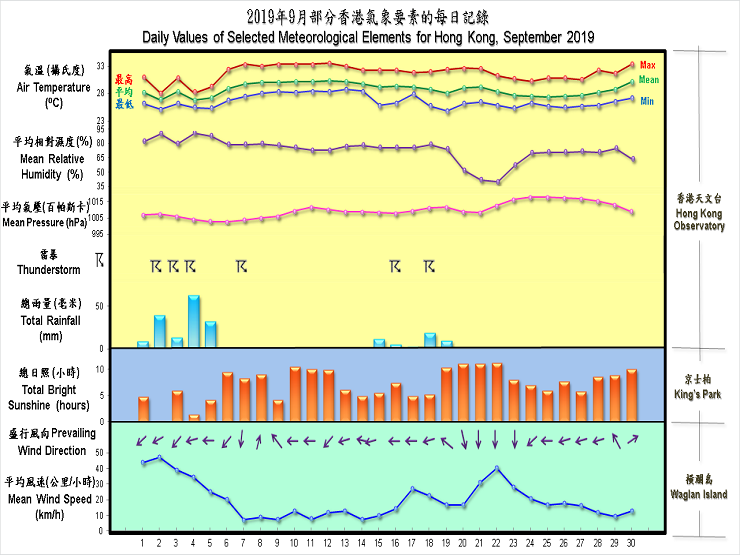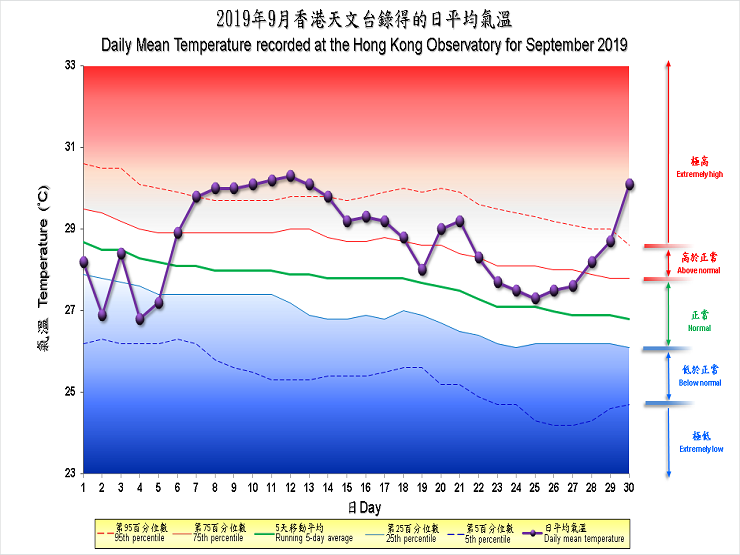The Weather of September 2019
3 October 2019
With the dominance of upper-air anticyclone over southern China for most of the time in the month, Hong Kong experienced a hot, sunny and dry September in 2019. The monthly mean temperature was 28.7 degrees, 1.0 degree above the normal figure of 27.7 degrees and the seventh highest on record for September. There were seven consecutive hot nights from 8 to 14 September, the longest on record for September. Moreover, up to September, the annual number of hot nights in 2019 already reached 45, which is 27.2 days above the annual normal and the highest on record since 1884. September 2019 was marked by sunny weather with the monthly total sunshine duration amounting to 216.3 hours, about 26 percent above the normal of 172.3 hours. The month was also drier than usual with a total rainfall of 198.9 millimetres, about 61 percent of the normal figure of 327.6 millimetres. The accumulated rainfall this year up to September was 2233.2 millimetres, on par with the normal figure of 2233.1 millimetres for the same period.
An area of low pressure intensified into a tropical depression over the northern part of the South China Sea on the first day of September and later named as Kajiki. It moved generally westward across the northern part of the South China Sea and made landfall over the southeastern coast of Hainan Island on the morning of 2 September. Kajiki entered the seas south of Hainan Island in the afternoon and moved slowly towards central Vietnam. Kajiki then lingered over the vicinity of the coast of central Vietnam on 3 September and weakened into an area of low pressure over there on the morning of 4 September.
Under the combined effect of Kajiki and the continental anticyclone, local weather became windy with occasional squally showers and thunderstorms in the afternoon of 1 September and remained so on the next two days. The showers were particularly heavy on 2 September with more than 50 millimetres of rainfall over most parts of the territory and rainfall even exceeding 100 millimetres over Sai Kung, Sha Tin and Tai Po. Affected by a broad trough of low pressure over the northern part of the South China Sea, the weather in Hong Kong remained unstable with occasional heavy showers and thunderstorms on 4 – 5 September. More than 40 millimetres of rainfall were recorded in many places and the rainfall recorded at Hong Kong Observatory even exceeded 90 millimetres in these two days.
Under the influence of a continental airstream, local weather became generally fine and very hot on 6 – 9 September. The high temperature also triggered thundery showers on the afternoons of 7 - 9 September. With the anticyclone aloft over southeastern China strengthening gradually, the generally fine and very hot weather continued on 10 – 13 September. With plenty of sunshine, the maximum temperature at the Observatory soared to 33.5 degrees on 12 September, the highest of the month. Moreover, the maximum temperature at the Observatory reached 33.0 degrees on 13 September, making it the hottest Mid-Autumn Festival on record.
With the weakening of the anticyclone aloft and under light wind conditions, it was hot with a mixture of sunshine and thundery showers in Hong Kong on 14 – 17 September. The showers were rather heavy and localized on 17 September. More than 50 millimetres of rainfall were recorded over Tuen Mun and Yuen Long and the rainfall even exceeded 100 millimetres over the western part of Lantau Island. With the anticyclone aloft strengthening again, apart from a few showers and thunderstorms in the morning and at night, the weather improved gradually on 18 September. While there were still a few showers in the morning, the weather turned fine and dry in the afternoon of 19 September. The temperature of the Observatory dropped to 24.9 degrees under the morning showers on 19 September, the lowest of the month. With the prevalence of the dry northeast monsoon over South China, the weather remained generally fine and dry for the rest of the month. The weather was very dry during the day on 20 – 22 September with the relative humidity over parts of the territory fell below 40 percent. It was also hazy on the last three days of the month with the visibility in the harbour fell below 4000 metres.
Six tropical cyclones occurred over the South China Sea and the western North Pacific in the month.
Details of issuance and cancellation of various warnings/signals in the month are summarized in Tables 1.1 to 1.6. Monthly meteorological figures and departures from normal for September are tabulated in Table 2.
Warnings and Signals issued in September 2019
| Name of Tropical Cyclone |
Signal Number |
Beginning Time | Ending Time | ||
|---|---|---|---|---|---|
| Day/Month | HKT | Day/Month | HKT | ||
| KAJIKI | 1 | 1 / 9 | 0840 | 1 / 9 | 1620 |
| 3 | 1 / 9 | 1620 | 2 / 9 | 1040 | |
| 1 | 2 / 9 | 1040 | 3 / 9 | 0920 | |
| Beginning Time | Ending Time | ||
|---|---|---|---|
| Day/Month | HKT | Day/Month | HKT |
| 21 / 9 | 0905 | 21 / 9 | 1200 |
| 22 / 9 | 0530 | 22 / 9 | 1330 |
| Colour | Beginning Time | Ending Time | ||
|---|---|---|---|---|
| Day/Month | HKT | Day/Month | HKT | |
| Amber | 2 / 9 | 1225 | 2 / 9 | 1400 |
| Beginning Time | Ending Time | ||
|---|---|---|---|
| Day/Month | HKT | Day/Month | HKT |
| 1 / 9 | 0945 | 1 / 9 | 1045 |
| 1 / 9 | 1345 | 1 / 9 | 2100 |
| 1 / 9 | 2320 | 2 / 9 | 0300 |
| 2 / 9 | 0435 | 2 / 9 | 1930 |
| 2 / 9 | 2025 | 2 / 9 | 2230 |
| 3 / 9 | 0547 | 3 / 9 | 0715 |
| 3 / 9 | 2255 | 4 / 9 | 1900 |
| 5 / 9 | 0215 | 5 / 9 | 0700 |
| 7 / 9 | 1535 | 7 / 9 | 1720 |
| 8 / 9 | 1330 | 8 / 9 | 1500 |
| 9 / 9 | 1350 | 9 / 9 | 1500 |
| 14 / 9 | 1405 | 14 / 9 | 1545 |
| 14 / 9 | 1755 | 14 / 9 | 1900 |
| 14 / 9 | 2110 | 14 / 9 | 2300 |
| 15 / 9 | 0525 | 15 / 9 | 0930 |
| 16 / 9 | 0115 | 16 / 9 | 0700 |
| 16 / 9 | 1725 | 16 / 9 | 1845 |
| 17 / 9 | 0245 | 17 / 9 | 0345 |
| 17 / 9 | 1305 | 17 / 9 | 2000 |
| 18 / 9 | 2030 | 19 / 9 | 0300 |
| Colour | Beginning Time | Ending Time | ||
|---|---|---|---|---|
| Day/Month | HKT | Day/Month | HKT | |
| Yellow | 13 / 9 | 0600 | 14 / 9 | 1100 |
| Red | 20 / 9 | 0600 | 23 / 9 | 1945 |
| Yellow | 28 / 9 | 0600 | 28 / 9 | 1845 |
| Yellow | 29 / 9 | 0600 | 29 / 9 | 1800 |
| Beginning Time | Ending Time | ||
|---|---|---|---|
| Day/Month | HKT | Day/Month | HKT |
| 7 / 9 | 1045 | 7 / 9 | 1800 |
| 8 / 9 | 0645 | 8 / 9 | 1730 |
| 9 / 9 | 1145 | 10 / 9 | 1800 |
| 11 / 9 | 1145 | 13 / 9 | 1800 |
| 20 / 9 | 0745 | 20 / 9 | 1800 |
| 30 / 9 | 1100 | 30 / 9 | 1900 |
| Meteorological Element | Figure of the Month | Departure from Normal* |
|---|---|---|
| Mean Daily Maximum Air Temperature | 31.8 degrees C | 1.7 degrees above normal |
| Mean Air Temperature | 28.7 degrees C | 1.0 degree above normal |
| Mean Daily Minimum Air Temperature | 26.6 degrees C | 0.8 degree above normal |
| Mean Dew Point Temperature | 23.1 degrees C | 0.3 degree below normal |
| Mean Relative Humidity | 73 % | 5 % below normal |
| Mean Cloud Amount | 50 % | 16 % below normal |
| Total Rainfall | 198.9 mm | 128.7 mm below normal |
| Number of hours of Reduced VisibilityΔ | 30 hours | 45.2 hours below normal§ |
| Total Bright Sunshine Duration | 216.3 hours | 44.0 hours above normal |
| Mean Daily Global Solar Radiation | 17.95 Megajoule / square metre | 3.34 Megajoule above normal |
| Total Evaporation | 129.9 mm | 4.0 mm above normal |
| Remarks : | All measurements were made at the Hong Kong Observatory except sunshine,
solar radiation and evaporation which were recorded at King's Park
Meteorological Station and visibility which was observed at the Hong
Kong International Airport. |
| Δ | The visibility readings at the Hong Kong International Airport are based on hourly observations by professional meteorological observers in 2004 and before, and average readings over the 10-minute period before the clock hour of the visibility meter near the middle of the south runway from 2005 onwards. The change of the data source in 2005 is an improvement of the visibility assessment using instrumented observations following the international trend.
|
* Departure from 1981 - 2010 climatological normal, except for number of hours of reduced visibility |
|
§ Departure from mean value between 1997 and 2018 |
|


| Remarks : | Extremely high: above 95th percentile Above normal: between 75th and 95th percentile Normal: between 25th and 75th percentile Below normal: between 5th and 25th percentile Extremely low: below 5th percentile Percentile and 5-day running average values are computed based on the data from 1981 to 2010 |
